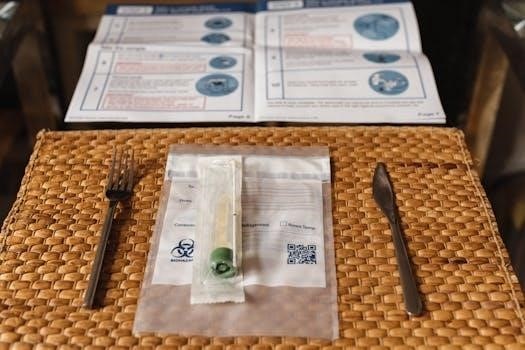
Apivar Strips⁚ An Overview
Apivar strips are a popular treatment for varroa mites in bee colonies, utilizing the active ingredient amitraz. These strips are designed for easy application, fitting between brood frames. They work through contact, distributing the miticide as bees move, offering a practical solution for mite control.
What are Apivar Strips?
Apivar strips are a specialized bee medication, primarily used for controlling varroa mite infestations within honeybee colonies. These strips are composed of a plastic polymer infused with amitraz, the active ingredient that targets varroa mites. They are designed as rigid, easy-to-handle strips that can be placed directly into the hive, specifically within the brood chamber. Each strip is engineered to release amitraz gradually over an extended period, ensuring continuous exposure to the mites. The unique construction of Apivar strips allows the active ingredient to be distributed throughout the hive as bees come into contact with the strips, carrying the amitraz on their bodies. Apivar is distinguished by its dual-action approach, effectively addressing both existing mite populations and emerging generations. They serve as a crucial component in integrated pest management, helping beekeepers maintain healthy colonies by combating varroa mites effectively. The strips come in sealed packages to maintain their efficacy until use, and they are a key tool for beekeepers globally.

Active Ingredient⁚ Amitraz
The active ingredient in Apivar strips is amitraz, a well-established acaricide that is specifically effective against varroa mites. Amitraz is a synthetic compound belonging to the class of formamidines, known for its ability to disrupt the nervous system of mites. It functions as a neurotoxin, causing overstimulation and paralysis in varroa mites, which are then unable to hold onto the bees and fall off. This mode of action is crucial for controlling mite populations within the beehive. The concentration of amitraz in Apivar strips is carefully controlled to ensure its efficacy against varroa mites while being safe for honeybees when used as directed. Amitraz is delivered through a unique polymer strip, designed to release the active ingredient gradually, ensuring consistent exposure over an extended period. It is essential to note that amitraz is effective against mites through contact, meaning that the mites must physically encounter the treated areas to be affected. This active ingredient is a critical component of the Apivar treatment, providing a reliable method for beekeepers to manage varroa mite infestations effectively.
How Apivar Strips Work
Apivar strips work through a contact-based mechanism, utilizing the active ingredient amitraz to control varroa mite infestations. The amitraz is embedded within a polymer matrix that releases it gradually over time. As bees move through the hive, they come into contact with the strips, picking up the amitraz on their bodies. This contact is crucial to the strip’s effectiveness; the bees then distribute the active ingredient throughout the hive through their normal movements and interactions. The amitraz acts on the mites’ nervous system, causing paralysis, which prevents them from clinging to the bees. Consequently, the affected mites fall to the bottom of the hive, ultimately leading to their demise. The strips are designed to ensure a sustained release of amitraz, creating an environment where varroa mites are consistently exposed to the active ingredient. This continuous exposure is vital for targeting both the phoretic mites on adult bees and those emerging from brood cells. Apivar does not work by evaporation; it is purely a contact miticide. The way the bees themselves spread the active ingredient is a key aspect of the treatment’s effectiveness, ensuring that the entire colony is reached.
Apivar Strip Composition
Apivar strips are composed of two primary components⁚ the active ingredient, amitraz, and a plastic polymer matrix. The active ingredient, amitraz, is an acaricide that targets varroa mites by disrupting their nervous system. It is a crucial part of the strip’s effectiveness, working to paralyze the mites and cause them to fall off the bees. The amitraz is not present in a pure form within the strip; instead, it is blended into a specially formulated polymer matrix. This matrix is designed to ensure a controlled and gradual release of amitraz over time. The polymer strip acts as a carrier for the amitraz and is chosen for its rigidity and ability to maintain a consistent release of the active ingredient upon contact with the bees. This polymer is specially designed to release amitraz on the surface of the strip after it is placed in the hive. The strips are vacuum-sealed until opened, and the release of amitraz is activated when the package is opened. This two-component system allows for easy handling and controlled application of the miticide, ensuring that the bees will efficiently spread the active ingredient throughout the hive.
Application of Apivar Strips
The application of Apivar strips is a straightforward process designed for ease of use by beekeepers. The strips, which are rigid and pre-cut to fit between brood frames, are placed directly into the hive. Typically, one strip is positioned between every five frames of bees within the brood chamber. This placement ensures that the bees will have ample contact with the strips as they move through the hive. The strips should be positioned so that bees can access both sides of them; It is important to handle the strips with care and to ensure they are securely placed, preventing them from falling to the bottom of the hive. Apivar strips are designed to fit neatly between the frames, eliminating the need for cutting or bending. The strips are not individually wrapped, so it is important to use them within two weeks of opening the package. It is recommended to perform a mite test before, during, and after treatment. It’s critical to ensure that honey supers are removed from the hive before applying Apivar strips, as the treatment is not meant to be used when honey is being produced for human consumption.
Timing of Apivar Treatment
Apivar treatment can be implemented at various times of the year, though it’s crucial to avoid application when honey supers are present on the hive, as this can lead to contamination of the honey. The most effective timing for Apivar treatment is when the honey flow has ceased and before the bees cluster for winter. This period allows the strips to work without affecting the honey intended for harvest. It’s beneficial to apply Apivar after the last honey extraction. Treatment can be used in both hot and cold weather, making it versatile for beekeepers in different climates. A key factor in the timing of treatment is the presence of brood; the larger the brood area, the longer the strips may need to be left in the hive, up to a maximum of eight weeks. Monitoring mite levels before, during, and after treatment is essential to determine the effectiveness of the application. Apivar treatment is beneficial for reducing mite populations and improving the health of the bee colony when applied at the right time.
Duration of Treatment
The recommended duration for Apivar strip treatment is a minimum of 42 days, or six weeks. However, the period can extend up to eight weeks, especially in hives with larger brood areas, to ensure a complete treatment cycle. It’s critical to keep the strips in the hive for the entire recommended duration to allow the active ingredient, amitraz, to effectively reach phoretic mites as they emerge from capped cells with young bees. This extended period ensures that both existing mites and emerging generations are targeted, reducing the overall mite population within the hive. The polymer strip is designed to release amitraz continuously over time, which is why the recommended treatment period is crucial for success. After the treatment period, the strips should be removed and discarded; they are not meant to be reused. Following the precise duration of treatment is essential for the strips to provide a full dose of the active ingredient, ensuring the best control of varroa mites.
Number of Strips per Hive

For effective treatment with Apivar strips, the standard recommendation is to use two strips per brood chamber within a hive. This dosage is designed to provide sufficient contact with the bee population, ensuring adequate distribution of the active ingredient, amitraz. The strips are typically placed between the brood frames, allowing the bees to walk on them and pick up the miticide. This contact method is crucial for the strips to work effectively. Each Apivar pack contains 10 strips, which is enough to treat five individual hives. It is important to insert the correct number of strips to ensure proper control of the varroa mite population. Using less than the recommended amount may not achieve the desired results. The placement should also ensure that bees can access both sides of the strips. Adjustments might be necessary for larger hives, but the base guideline of two strips per brood chamber must remain consistent for best results. Remember to space the strips evenly in the brood area.

Shelf Life and Storage
Apivar strips have a shelf life of 24 months from the manufacturing date, which is stamped on the bottom of the package. It is crucial to check this date before use to ensure the strips are still effective. The strips are made from a polymer material blended with the active ingredient, amitraz. They are vacuum-sealed at the time of manufacture to prevent the release of amitraz until the package is opened. Once opened, the strips should be used within 2 weeks to maintain their potency. Proper storage is essential to preserve the efficacy of the strips. They should be kept in a cool, dry place, away from direct sunlight and extreme temperatures. Exposure to heat or moisture can degrade the active ingredient. It is also advisable to store them in their original packaging until ready for use. Always follow the storage recommendations to maximize the effectiveness of the Apivar treatment. Avoid storing opened packages for extended periods, as the amitraz may degrade or evaporate; If the packaging is damaged, the strips may not be effective.
Key Considerations for Effective Treatment
For Apivar strips to be effective, several key considerations must be observed. Firstly, it is crucial to apply the strips when honey supers are not on the hive. This prevents any contamination of the honey intended for human consumption. The strips should be placed within the brood chamber, ensuring bees can walk on both sides for optimal contact. Timing is also critical; Apivar can be used in any season when honey supers are absent. The duration of treatment should be between 6 to 8 weeks, with longer periods recommended for larger brood areas. Mite testing before, during, and after treatment is essential to monitor the infestation level and evaluate the treatment’s success. Remove strips after treatment, and never reuse them. Proper placement is crucial for even distribution of the active ingredient. The strips work via contact, so it is important they are in areas of peak bee activity. Avoid storing opened packets for extended periods as effectiveness decreases. Adhering to these considerations will maximize the efficacy of Apivar.
Safety and Effectiveness
Apivar strips have been rigorously tested, demonstrating a high degree of safety and effectiveness when used correctly. The active ingredient, amitraz, targets varroa mites specifically, with a proven track record of controlling mite infestations. It works through contact, ensuring the bees distribute the miticide throughout the hive. Apivar is designed to be safe for bees when used as directed, and it’s considered the only amitraz-based product that treats multiple generations of varroa mites. Its unique controlled-release technology ensures a continuous delivery of the active ingredient over a 6 to 10 week period. The strips are made of a polymer material that is blended with the active ingredient, and upon opening the vacuum-sealed package, the amitraz is released. This controlled release method minimizes harm to bees while maximizing its effectiveness against mites. Scientific trials consistently show efficacy rates between 97 and 99%. While Apivar is generally safe for bees, it’s important to follow the recommended treatment guidelines to ensure the best results and avoid potential harm to the colony.

Leave a Reply
You must be logged in to post a comment.